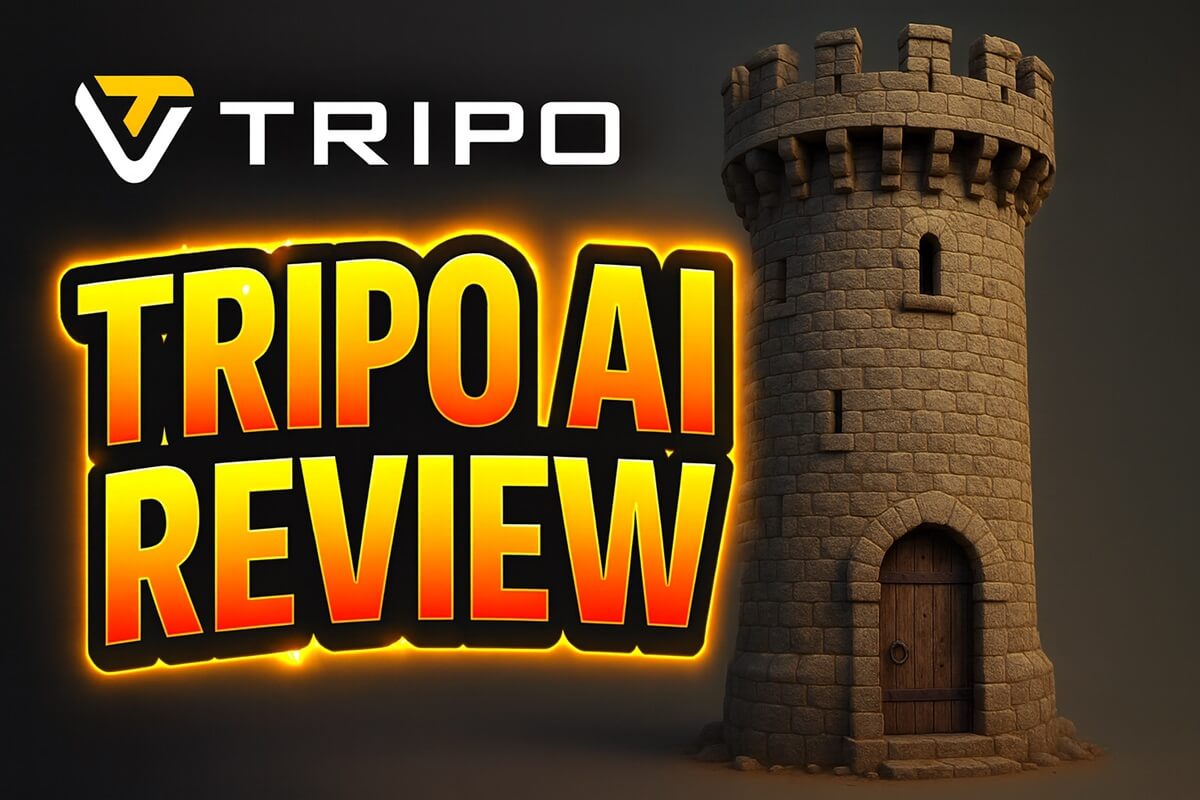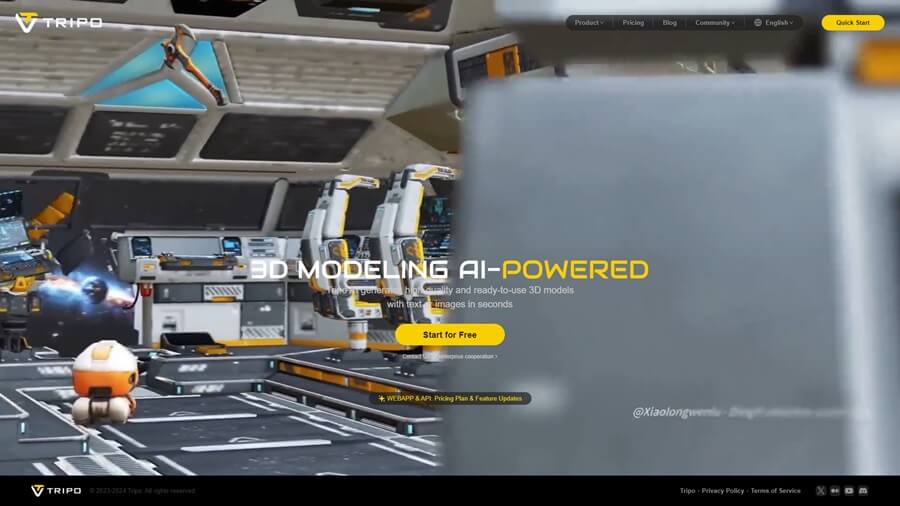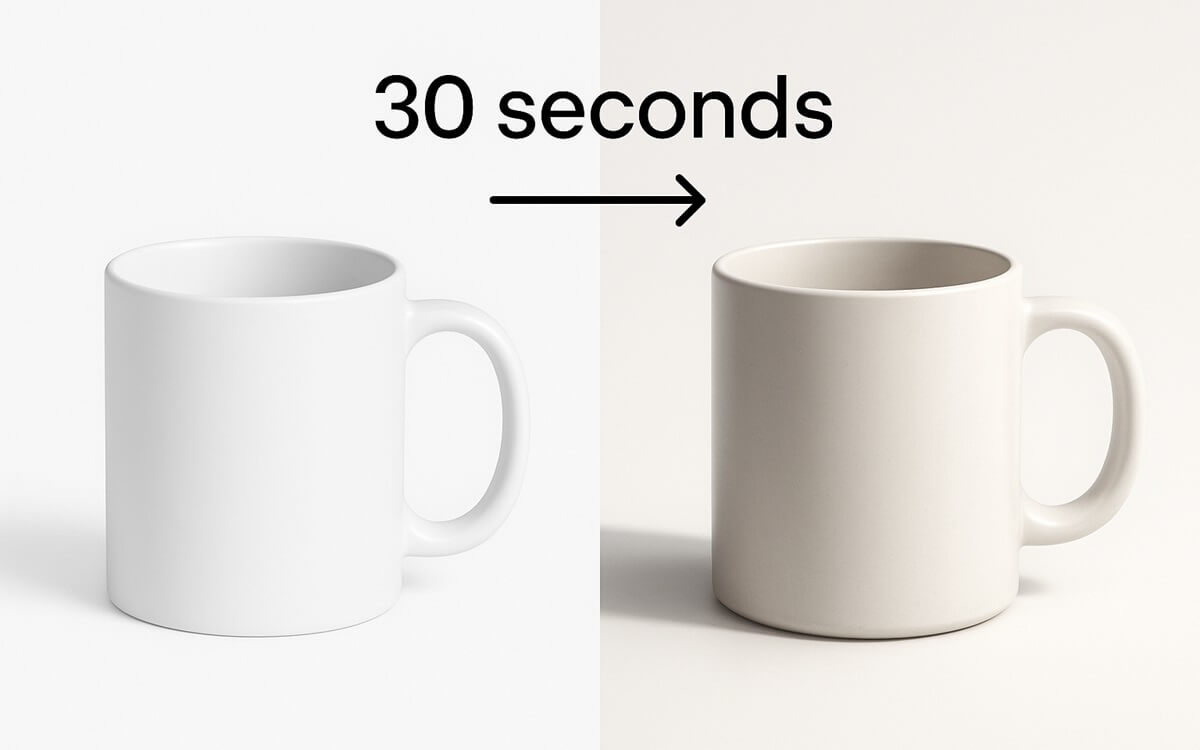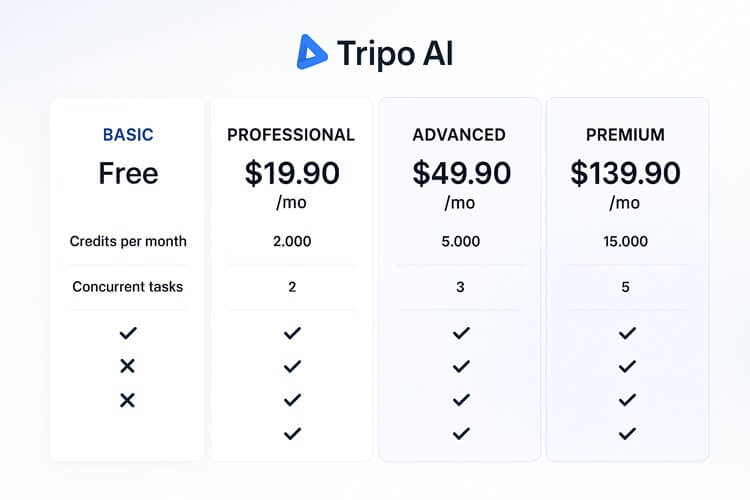Honest Tripo AI Review: Is It Really a Game-Changer for 3D Modeling?
We tested its speed, quality, and practical use cases to see if it lives up to the hype and saves you time and money.

Tripo Ai 3D Modelling Review

Tripo AI is a generative 3D modeling tool that creates 3D models from text or images in under a minute. It stands out for its remarkable speed and user-friendly interface, making 3D creation accessible even for beginners. The platform produces models with clean geometry and realistic textures, offering professional features like auto-rigging and versatile export options. While it can sometimes struggle with complex details and its free plan has attribution requirements, Tripo AI represents a significant leap forward. It dramatically accelerates and democratizes the 3D design workflow, positioning itself as a powerful and promising asset for rapid prototyping and content creation.
Application Category: 3D Asset Creation
4
Pros
- Creates 3D models in under a minute.
- Easy interface for non-experts.
- Many export options for different platforms.
- Excellent prompt refinement for improvements.
- Algorithm 3.0 gives cleaner geometry and textures.
- Pro features like auto-rigging rival traditional tools.
Cons
- Only 1 in 10 models are client-ready.
- Struggles with complex or organic shapes.
- Sometimes, textures can look unrealistic or cartoonish.
The demand for 3D assets has exploded across gaming, marketing, and product visualization. Traditional 3D modeling requires years of training and specialized software, creating a massive bottleneck for creative teams.
This gap has opened the door for AI-powered 3D generators promising to democratize 3D creation.
Tripo AI positions itself as a solution that transforms text prompts and images into production-ready 3D models in seconds [1]. But does it actually deliver on this promise, or is it another overhyped AI tool that falls apart under real-world pressure?
We spent weeks testing Tripo AI’s capabilities across different use cases, from rapid prototyping to game asset creation. Here’s what we found, without the marketing fluff.
• Exports to GLB, FBX, OBJ for all major platforms
• Auto-rigging and T-pose generation for characters
• Algorithm 3.0 delivers cleaner geometry than competitors
• Struggles with complex geometry and fine details
• Free plan requires CC BY 4.0 attribution
• Queue delays for free users during peak times
What is Tripo AI? A Quick Overview
Tripo AI is a web-based platform that generates 3D models from text prompts and images, targeting creators who need fast 3D asset creation without the traditional modeling pipeline [2].
At its core, the platform offers two primary generation methods: text-to-3D and image-to-3D conversion.
Core Functionality:
- Text-to-3D Generation: Create models from descriptive prompts
- Image-to-3D Conversion: Transform single or multiple reference images into 3D assets
- Export Options: Multiple formats including GLB, FBX, OBJ, USD, and STL [3]
- Auto-Rigging: T-pose character generation with skeletal binding included
- Batch Processing: Upload multiple images for simultaneous generation
Primary Use Cases:
The platform primarily serves indie game developers, 3D artists, product designers, marketers, and educators who need rapid prototyping capabilities [4].
Unlike professional 3D software that requires extensive training, Tripo AI focuses on accessibility and speed over granular control.
Key Features:
- Dual output modes: Standard (optimized topology) and Ultra (up to 2 million polygons)
- PBR texture generation with realistic material properties
- Magic Brush 2.0 for selective editing and refinement
- Smart part segmentation for complex model organization
- Direct integration with Flux and GPT-4o image generators
How Easy is it to Use Tripo AI?
The user interface immediately strikes you as refreshingly simple.
There’s no cluttered toolbar or overwhelming options menu – just a clean workspace with clear prompts for text or image input.
The generation process follows a straightforward workflow: input your prompt or upload an image, select your preferred mode (Standard or Ultra), and hit generate.
The platform offers “one-click generation” for quick results or “build and refine” options for iterative improvements [5].
For anyone familiar with web applications, Tripo AI requires virtually no learning curve.
The interface feels intuitive, with helpful tooltips and clear visual feedback throughout the generation process.
Even complete 3D modeling beginners can produce usable results within minutes of their first login [6].
However, getting professional-quality results still requires understanding basic 3D concepts like topology, UV mapping, and export formats.
The platform abstracts away the technical complexity but doesn’t eliminate the need for creative judgment.
Hands-On Test: Putting Tripo AI Through Its Paces
I’ve put Tripod Ai to the test. The results were more than satisfactory – at least for me. Here are two examples from the many I used.
The Text-to-3D Test
Test Prompt:
"Medieval stone watchtower with wooden door and iron-bound details, weathered stone texture"
The generated model captured the basic architectural form surprisingly well. The geometry maintained clean edges and coherent structure, addressing one of the major weaknesses we’ve seen in earlier AI 3D generators.
The stone texture appeared realistic with appropriate weathering effects, and the wooden door element was recognizable and proportionally correct.
Quality Analysis:
- Mesh Quality: Clean topology suitable for game engines, with minimal non-manifold geometry
- Texture Adherence: Strong correlation between prompt description and visual output
- Geometric Accuracy: Proportions and structural elements matched expectations
- Surface Detail: Fine details like stone weathering and metal bindings were clearly visible
The Image-to-3D Test
Source Image: High-resolution product photo of a ceramic coffee mug
The image-to-3D conversion demonstrated the platform’s ability to extrapolate 3D form from 2D reference material. The resulting model maintained the mug’s proportions and surface details, including the handle geometry and rim thickness.
Conversion Accuracy:
- Form Fidelity: 85% accuracy in overall shape and proportions
- Surface Details: Handle attachment and rim details preserved
- Texture Quality: Surface patterns and color information translated effectively
- Topology Assessment: Geometry remained animation-friendly with proper edge flow
⚡ Performance and Speed:
Generation times averaged 15-30 seconds for Standard mode and 45-60 seconds for Ultra mode, significantly faster than traditional modeling workflows [7]. Free plan users may experience queue delays during peak usage periods, while paid subscribers receive priority processing [8].
Tripo AI’s Key Features Explored
1. Exporting and Integration
Tripo AI supports comprehensive export options including GLB, FBX, OBJ, USD, STL, and Schematic formats [9]. This versatility addresses one of the biggest pain points in 3D workflows = format compatibility across different platforms.
Format Selection Guidelines:
- GLB: Optimal for web applications, AR viewers, and mobile deployment
- FBX: Best choice for Unity, Unreal Engine, and animation-heavy projects
- OBJ: Universal compatibility for 3D printing and simple mesh exchange
- USD: Ideal for complex scene hierarchies and collaborative pipelines
The platform provides detailed guidance on when to use each format, helping users avoid common compatibility issues [10].
Texturing and Materials
The Algorithm 3.0 update significantly improved texture generation, delivering more realistic PBR (Physically Based Rendering) materials that respond naturally to lighting [11].
Colors map more faithfully to source images, and material properties like metallic reflection and surface roughness appear more convincing than previous versions.
Texture Quality Assessment:
- Resolution: HD textures available in paid plans
- PBR Compliance: Albedo, normal, roughness, and metallic maps generated automatically
- Material Accuracy: Improved prediction of surface properties and light interaction
- Fine Details: Enhanced reproduction of embedded text, micro-patterns, and surface engravings
Rigging and Animation
The auto-rigging feature generates characters in T-pose with skeletal binding included, making them immediately compatible with animation tools like Mixamo [12]. This addresses a major workflow bottleneck for character-based projects.
Rigging Quality:
- Bone Placement: Anatomically correct joint positioning for humanoid characters
- Weight Painting: Automatic skin binding with minimal artifacts
- Animation Readiness: Direct compatibility with standard animation workflows
- Export Support: Rigged models export cleanly to FBX format
Tripo AI Pricing: Is It Worth the Cost?
Tripo AI operates on a credit-based system with four distinct tiers:
Basic Plan (Free)
- 300 credits monthly
- 1 concurrent task
- 1-day history record
- Limited export formats
- Public models under CC BY 4.0 license [13]
Professional Plan ($19.90/month)
- 3,000 credits monthly
- 10 concurrent tasks
- 7-day history record
- All export formats
- Private models with commercial use rights
- Priority queue processing
Advanced Plan ($49.90/month)
- 8,000 credits monthly
- 15 concurrent tasks
- 30-day history record
- All premium features included
Premium Plan ($139.90/month)
- 20,000 credits monthly
- 20 concurrent tasks
- Permanent history record
- Exclusive advanced features
Cost-Benefit Analysis:
For indie developers and hobbyists, the Professional plan offers the best value, providing sufficient credits for regular prototyping while including commercial use rights. Teams requiring high-volume production should consider Advanced or Premium tiers.
Compared to traditional 3D modeling costs (software licenses + artist salaries), Tripo AI presents significant savings for specific use cases, particularly rapid prototyping and background asset creation.
Tripo AI Pros and Cons: A Balanced View
✅ What We Liked (Pros)
- Speed and Accessibility: Generate usable 3D models in under a minute, dramatically faster than traditional workflows
- User-Friendly Interface: Minimal learning curve makes 3D creation accessible to non-experts
- Format Versatility: Comprehensive export options ensure compatibility across different platforms and engines [14]
- Iterative Refinement: Best-in-class prompt refinement capabilities for iterative improvements [15]
- Quality Improvements: Algorithm 3.0 delivers significantly cleaner geometry and more realistic textures
- Professional Features: Auto-rigging, batch processing, and PBR textures rival traditional modeling outputs
😱 Where It Falls Short (Cons)
- Consistency Issues: Approximately 1 in 10 generations are client-ready without manual cleanup [16]
- Complex Geometry Limitations: Struggles with intricate details, organic forms, and multi-part assemblies
- Texture Hallucinations: AI-generated textures occasionally produce unrealistic or cartoonish results [17]
- Queue Times: Free users experience delays during peak usage periods
- Limited Fine Control: Less precise than traditional modeling for specific design requirements
- Attribution Requirements: Free plan models require CC BY 4.0 attribution, limiting commercial flexibility
Tripo AI Alternatives: How Does It Compare?
Based on the Tripo AI review, here’s a comparison table of the four 3D modeling platforms:
3D Modeling Platform Comparison
| Feature | Tripo AI | Meshy AI | Kaedim | Spline |
|---|---|---|---|---|
| Primary Approach | AI-powered text/image to 3D | AI generation with presets | Artist-in-the-loop hybrid | Real-time collaborative design |
| Generation Speed | 15-60 seconds | Similar to Tripo | Slower (human oversight) | Manual modeling required |
| Quality Consistency | 1 in 10 client-ready | Lower success rate | Higher guaranteed quality | Full creative control |
| Best For | Rapid prototyping, indie devs | Preset-driven workflows | Studios needing pro quality | Collaborative 3D design |
| Pricing | Free: 300 credits/month Pro: $19.90/month | Not specified | Higher cost | Not specified |
| Key Strengths | • Fast generation • Auto-rigging • Multiple export formats • Clean geometry | • Extensive preset library • AI texturing • Active development | • Artist quality control • Game-ready focus • Predictable results | • Real-time collaboration • Web-native tools • Full design control |
| Main Weaknesses | • Consistency issues • Complex geometry limits • Queue times (free) | • Higher failure rate • Weaker geometry quality | • Higher cost • Slower turnaround • Requires human oversight | • Less AI automation • More manual work • Different category |
| Export Formats | GLB, FBX, OBJ, USD, STL | Not specified | Game-ready formats | Web-focused |
| Learning Curve | Minimal | Easy with presets | Professional knowledge needed | Moderate |
| Commercial Use | Paid plans include rights | Not specified | Professional licensing | Not specified |
Meshy AI
- Strengths: Extensive preset library, AI texturing capabilities, active development roadmap
- Weaknesses: Higher failure rate in our testing, weaker geometry quality
- Best For: Users who prefer preset-driven workflows and need specific AI texturing features
Kaedim
- Strengths: Artist-in-the-loop approach ensures higher quality, game-ready focus
- Weaknesses: Higher cost, slower turnaround, requires human oversight
- Best For: Studios needing guaranteed professional quality with predictable results
Spline
- Strengths: Real-time collaborative editing, web-native design tools
- Weaknesses: Less focused on AI generation, more manual modeling required
- Best For: Teams needing collaborative 3D design workflows
Comparison Summary:
Tripo AI strikes the best balance between automation and quality among pure AI generators.
Kaedim offers higher quality but at significantly higher cost and longer timelines.
Meshy provides similar features but with less consistent results in our testing.
Spline, however, operates in a different category entirely – it’s best for designers who want full creative control with collaborative features and web integration.
Who Should Use Tripo AI (and Who Shouldn’t)
Ideal User Profile
- Indie game developers needing rapid prototyping and background assets
- Marketing teams creating product visualizations and web content
- Educators teaching 3D concepts without requiring expensive software
- Content creators producing YouTube thumbnails, concept art, and portfolio pieces
- Small studios exploring AI-assisted workflows for non-hero assets
When to Look Elsewhere
- You require pixel-perfect accuracy for hero assets or close-up viewing
- Your workflow demands complex multi-part assemblies or precise engineering tolerances
- Professional animation with advanced rigging controls is your primary need
- You need deterministic outputs with guaranteed quality for client deliverables
- Traditional modeling skills and software licenses aren’t cost constraints
The Verdict: Is Tripo AI Worth it?
Tripo AI represents a significant step forward in AI-powered 3D generation, particularly with the Algorithm 3.0 improvements. The platform successfully addresses many pain points that plagued earlier AI 3D tools: cleaner geometry, better textures, and more reliable outputs.
Key Strengths:
- Speed advantage is genuine = models generate 10-100x faster than manual modeling
- Quality reaches “good enough” threshold for background props, prototypes, and web assets
- Workflow integration is smoother than competitors, with excellent format support
- Cost efficiency is substantial for appropriate use cases
Realistic Limitations:
- Not yet ready for hero assets or precision manufacturing
- Still requires 3D knowledge for optimal results
- Success rate varies significantly based on prompt complexity and subject matter
Final Recommendation:
Tripo AI earns a qualified recommendation for teams that understand its current limitations. It’s an excellent accelerator for experienced 3D artists and a valuable entry point for newcomers to 3D creation. However, it’s not a replacement for traditional modeling skills = it’s a powerful supplement to existing workflows.
The platform works best when viewed as a rapid prototyping tool that can shortcut the early stages of 3D asset creation. For indie developers, marketers, and educators, it represents genuine value. For professional studios, it’s worth testing as a background asset accelerator while maintaining traditional pipelines for critical work.
FAQ Section
References
- [1] Tripo AI – “Create Your First 3D Model with Text and Image in Seconds”
- [2] Skywork AI – “Tripo AI Review 2025: Hands-On Evaluation for 3D Artists & Devs” – Sep 18, 2025
- [3] VideoSDK – “Tripo3d: AI 3D Model Generator – Text & Image to 3D”
- [4] Futurepedia – “Tripo AI Reviews: Use Cases, Pricing & Alternatives” – Sep 9, 2025
- [5] Tripo AI – “A Comprehensive Guide to Tripo’s Text-to-3D Model Feature”
- [6] Virtuall – “12 Best AI Tools for 3D Modeling to Use in 2025” – Sep 23, 2025
- [7] Tripo AI – “Tripo v3.0 Ultra Official Release: A New Benchmark in AI 3D Creation”
- [8] Tripo AI – “Pricing & Billing – Platform of Tripo AI”
- [9] Tripo AI – “Which AI 3D Format Should You Use: OBJ, FBX, or GLB?”
- [10] Tripo AI – “Importing AI Generated 3D Models into Blender”
- [11] Skywork AI – “My Hands-On Look at Tripo 3.0: The AI 3D Generator That Actually Feels Professional” – Sep 9, 2025
- [12] Tripo AI – “How to Import Characters into Unity”
- [13] Tripo AI – “Tripo Pricing | Flexible Plans for AI 3D Modeling Solutions”
- [14] Tripo AI – “One-Click Textures for Any Model”
- [15] SimInsights – “Is AI Ready for High‑Quality 3D Assets in 2025?” – Sep 3, 2025
- [16] SimInsights – “Is AI Ready for High‑Quality 3D Assets in 2025?” – Sep 3, 2025
- [17] VoxelMatters – “Tripo AI’s fast track to an AI-native 3D future” – Sep 17, 2025
- [18] Tripo AI – “Support & FAQ – Platform of Tripo AI”
- [19] Tripo AI – “Which AI 3D Format Should You Use: OBJ, FBX, or GLB?”
- [20] Tripo AI – “Tripo Pricing | Flexible Plans for AI 3D Modeling Solutions”
- [21] Tripo AI – “Pricing & Billing – Platform of Tripo AI”




